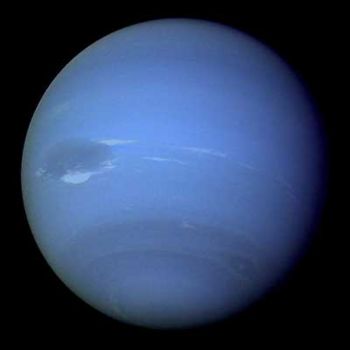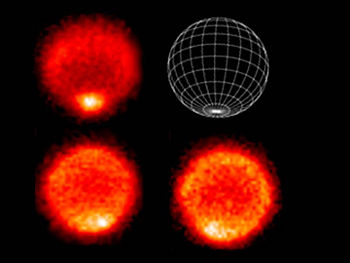Neptune: Difference between revisions
imported>Thomas Simmons |
imported>Thomas Simmons No edit summary |
||
| Line 1: | Line 1: | ||
'''Neptune''' is the eighth [[planet]] from the [[Sun]]. It is a [[gas giant]] (also known as a Jovian planet, after the planet [[Jupiter]]). | '''Neptune''' is the eighth [[planet]] from the [[Sun]]. It is a [[gas giant]] (also known as a Jovian planet, after the planet [[Jupiter]]). | ||
[[Image:Neptune NASA-JPL.jpg|right|thumb|350px|{{#ifexist:Template:Neptune NASA-JPL.jpg/credit|{{Neptune NASA-JPL.jpg/credit}}<br/>|}}Voyager 2 photo of Neptune taken in 1989]] | |||
==Parameters for classification as a planet== | ==Parameters for classification as a planet== | ||
Neptune is classified as a planet by the International Astronomical Union for meeting the following criteria:<ref>[http://www.nasa.gov/vision/universe/solarsystem/planetsf-20060824.html Honey, I Shrunk the Solar System] NASA. “The International Astronomical Union has decided that, to be called a planet, an object must have three traits. It must orbit the sun, be massive enough that its own gravity pulls it into a nearly round shape, and be dominant enough to clear away objects in its neighborhood.”</ref> | Neptune is classified as a planet by the International Astronomical Union for meeting the following criteria:<ref>[http://www.nasa.gov/vision/universe/solarsystem/planetsf-20060824.html Honey, I Shrunk the Solar System] NASA. “The International Astronomical Union has decided that, to be called a planet, an object must have three traits. It must orbit the sun, be massive enough that its own gravity pulls it into a nearly round shape, and be dominant enough to clear away objects in its neighborhood.”</ref> | ||
| Line 9: | Line 9: | ||
==Physical Characteristics== | ==Physical Characteristics== | ||
Neptune is approximately 30 times as far from the sun as Earth (30 AU), though slightly smaller than Uranus, is more dense and is about seventeen times more massive than Earth (17 Earth masses). At its distance from the Sun, it receives about one thousandth of the same sunlight as Earth.<ref name= NeptuneSouthPole>[http://www.nasa.gov/vision/universe/solarsystem/neptune-20070918.html A warm south pole on Neptune] NASA 18/09/07. Retrieved 4/11/07</ref> It radiates more internal heat than it receives from the sun, though less than Jupiter or Saturn, indicating a radioactive inner core.<ref>{{cite web|title=Post Voyager comparisons of the interiors of Uranus and Neptune|author=Podolak, M.; Reynolds, R. T.; Young, R.|work=NASA, Ames Research Center|year=1990|url=http://adsabs.harvard.edu/abs/1990GeoRL..17.1737P|accessdate= 2006-01-16 }}</ref> | Neptune is approximately 30 times as far from the sun as Earth (30 AU), though slightly smaller than Uranus, is more dense and is about seventeen times more massive than Earth (17 Earth masses). At its distance from the Sun, it receives about one thousandth of the same sunlight as Earth.<ref name= NeptuneSouthPole>[http://www.nasa.gov/vision/universe/solarsystem/neptune-20070918.html A warm south pole on Neptune] NASA 18/09/07. Retrieved 4/11/07</ref> It radiates more internal heat than it receives from the sun, though less than Jupiter or Saturn, indicating a radioactive inner core.<ref>{{cite web|title=Post Voyager comparisons of the interiors of Uranus and Neptune|author=Podolak, M.; Reynolds, R. T.; Young, R.|work=NASA, Ames Research Center|year=1990|url=http://adsabs.harvard.edu/abs/1990GeoRL..17.1737P|accessdate= 2006-01-16 }}</ref> | ||
[[Image:Thermal images of Neptune's polar region.jpg|right|thumb|350px|{{#ifexist:Template:Thermal images of Neptune's polar region.jpg/credit|{{Thermal images of Neptune's polar region.jpg/credit}}<br/>|}}ESO Very Large Telescope thermal images of Neptune's south polar region showing variation in temperature.]] | |||
The average temperature on Neptune is -200° C (392° F). Recent measurements have show the southern pole to be about 10° C hotter than the planet average. This results in the vaporisation of the frozen methane and its circulation to the upper layers of the atmosphere. Neptune is comprised predominantly of hydrogen and helium. However, its methane component reaches the upper atmosphere absorbing red light from sunlight and reflects the blue spectrum making Neptune appear blue.<ref name= NeptuneSouthPole/> | The average temperature on Neptune is -200° C (392° F). Recent measurements have show the southern pole to be about 10° C hotter than the planet average. This results in the vaporisation of the frozen methane and its circulation to the upper layers of the atmosphere. Neptune is comprised predominantly of hydrogen and helium. However, its methane component reaches the upper atmosphere absorbing red light from sunlight and reflects the blue spectrum making Neptune appear blue.<ref name= NeptuneSouthPole/> | ||
Revision as of 05:10, 8 November 2007
Neptune is the eighth planet from the Sun. It is a gas giant (also known as a Jovian planet, after the planet Jupiter).
Parameters for classification as a planet
Neptune is classified as a planet by the International Astronomical Union for meeting the following criteria:[1]
- Orbits the sun;
- Has mass sufficient for its gravity to form a nearly round shape;
- Has mass sufficient for gravity to clear a path in its orbit.
Physical Characteristics
Neptune is approximately 30 times as far from the sun as Earth (30 AU), though slightly smaller than Uranus, is more dense and is about seventeen times more massive than Earth (17 Earth masses). At its distance from the Sun, it receives about one thousandth of the same sunlight as Earth.[2] It radiates more internal heat than it receives from the sun, though less than Jupiter or Saturn, indicating a radioactive inner core.[3]
The average temperature on Neptune is -200° C (392° F). Recent measurements have show the southern pole to be about 10° C hotter than the planet average. This results in the vaporisation of the frozen methane and its circulation to the upper layers of the atmosphere. Neptune is comprised predominantly of hydrogen and helium. However, its methane component reaches the upper atmosphere absorbing red light from sunlight and reflects the blue spectrum making Neptune appear blue.[2]
Rotational Characteristics
Neptune’s polar orientation is similar to Earth’s with the northern pole tilting toward or away from the Sun in season. The northern hemisphere summers and winters lasts approximately 40 years each. The variation in polar tilts and increased temperature may be a contributing factor to the winds on Neptune which reach velocities of about 2,000 k/h (1,240 m/h)[2]
Orbital Characteristics
Neptune has an orbital period (sidereal year) of 164.79 earth years. At is closest approach to the Sun (perihelion) it is nearly 30 times the distance of the Earth from the Sun (29.80 AU). At its furthest distance from the Sun (aphelion) it is 30.32 AU from the Sun.[4]
Natural Satellites
Neptune has thirteen moons. The largest, Triton, is geologically active, with geysers of liquid nitrogen.[5] Triton is the only large satellite with a retrograde orbit. Neptune possesses a number of Trojan asteroids.
References
- ↑ Honey, I Shrunk the Solar System NASA. “The International Astronomical Union has decided that, to be called a planet, an object must have three traits. It must orbit the sun, be massive enough that its own gravity pulls it into a nearly round shape, and be dominant enough to clear away objects in its neighborhood.”
- ↑ 2.0 2.1 2.2 A warm south pole on Neptune NASA 18/09/07. Retrieved 4/11/07
- ↑ Podolak, M.; Reynolds, R. T.; Young, R. (1990). Post Voyager comparisons of the interiors of Uranus and Neptune. NASA, Ames Research Center. Retrieved on 2006-01-16.
- ↑ The orbits of the planets National Maritime Museum
- ↑ Duxbury, N.S., Brown, R.H. (1995). The Plausibility of Boiling Geysers on Triton. Beacon eSpace. Retrieved on 2006-01-16.

